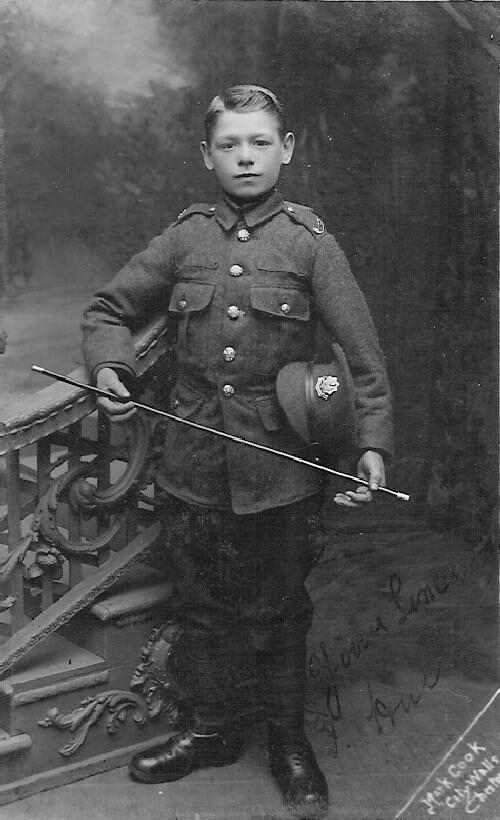
World War I: Boys in the British Army

Figure 1.-- I'm not sure how old this boy was, but he can't be much oldervthan 13 years. A photo dealer describes him as in The Cheshire Regiment during World War I. He has signed his name, T. Hull, in the lower right-hand corner. We would guess he is more likely to be in a school Cadet Corps, but we are not sure how to tell.
|
|
Young boys regularly served in the British Army during the 18th and 19th century. One of the most famous such boys is the drummervboy that appeared on the ramparts at Yorktown under ahite flag to signal that Lord Corrwallis was ready to discuss surender. Boys serving as musicians were still common during the 19th century. One aspect we notice is that at the turn of the 20th century such as in the Bohr War (1899-1902), the British were still accepting quite young boys in the army to serve as musicians. This no longer appears to be the case by World War I. Recruiters seem to have been somewhat more careful about following the regulations concerning age, at least rejecting the really youthful looking boys. Still boys not old enough to enlist did so by saying that they were 18 years old. One of the methods used was to write 18 on a piece of paper. This was put in the sole of their shoe. It was a deception to make the recruiting officer think they were the right age to enlist in the armed forces. The boys then could trufully say that they were over 18. The British Army never asked volunteers to prove their age by actually showing their birth certificate. The Army was very reluctant to change this procedure. If they looked any ehere near recruiting age were probably accepted. Even so we do see some portraits of some quite young soldiers. There is no way they could have been seen as old enough to serve. We are not sure just how the younger boys were used in the Army. Many questions being asked in Parliament. The National Service League also complained at the lax rules. They claimed that 15 percent of wartime volunteers were under age. The army compromised and did allow underage recruits to be sent home to their parents. It is believed my many authorities that the youngest boy to enlist in the British army was John Condon from Waterford, Ireland. It is claimed that he was 12 years old when he enlisted in the Royal Irish Regiment. John was killed in France (May 24, 1915). It was a German gas attack near Ypres. On his grave, however, it is stated that he was 14 years old. Some British public school pupils enrolled as a class. This also occurred in Germany. [Remarque] The military thinking of the day allowed the boys to stay together in the regiments they joined as a recruiting and morale factor and for unit cohesion. The problem as with the adult pal brigades was that in action whole school groups died. This happened on the Somme and in Flanders. There is a moving description of this in literature. [Hilton] At school assembly around 1915 Chips reads the names of former boys who were killed in action. The striking realization is that they were all in the same Latin set which Mr. Chips taught.
Sources
Hilton, James. Good Bye Mr. Chips. There is a whole genre of English school stories, mostly set a public (exclusive private) schools. This is perhaps the best known.
Remarque, Maria. All Quiet on the Western Front. This German classic was particularly hated by Hitler. It was included in the public book burnings staged by the NAZIs along with books written by Jewish authors after the NAZIs seized power.
HBC

Navigate the Boys' Historical Clothing Web Site:
[Return to Main British boy and youth volunteers page]
[Return to Main World War I age of soldiers page]
[Return to Main English cadet page]
[Introduction]
[Activities]
[Biographies]
[Chronology]
[Clothing styles]
[Countries]
[Bibliographies]
[Contributions]
[Essays]
[FAQs]
[Glossaries]
[Images]
[Links]
[Registration]
[Tools]
[Boys' Clothing Home]
Created: 6:50 AM 10/12/2007
Last updated: 6:51 AM 10/12/2007



